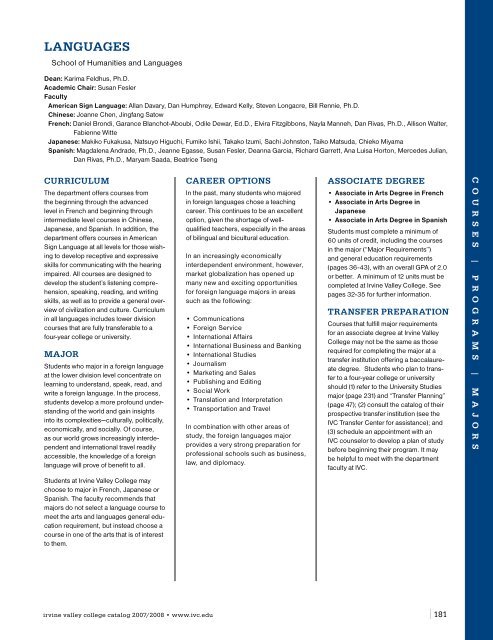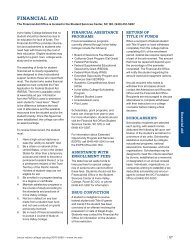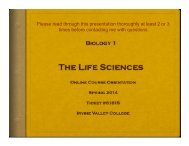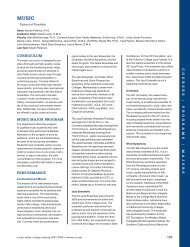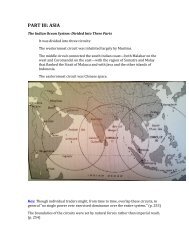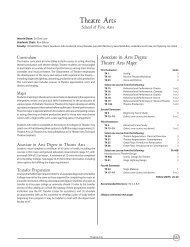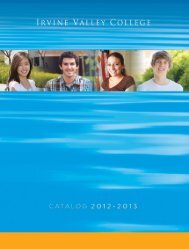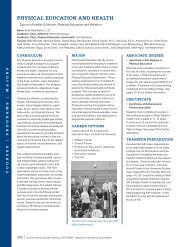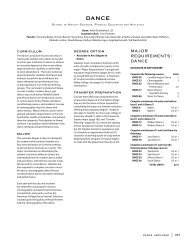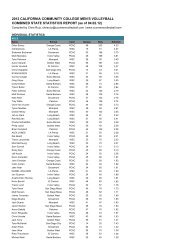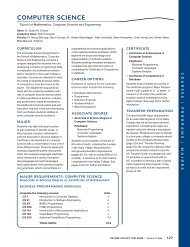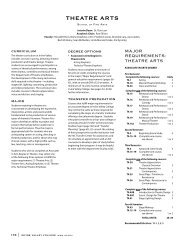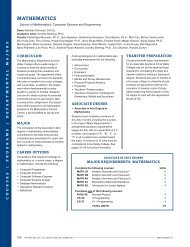LAnGUAGES - Irvine Valley College
LAnGUAGES - Irvine Valley College
LAnGUAGES - Irvine Valley College
You also want an ePaper? Increase the reach of your titles
YUMPU automatically turns print PDFs into web optimized ePapers that Google loves.
Languages<br />
School of Humanities and Languages<br />
Dean: Karima Feldhus, Ph.D.<br />
Academic Chair: Susan Fesler<br />
Faculty<br />
American Sign Language: Allan Davary, Dan Humphrey, Edward Kelly, Steven Longacre, Bill Rennie, Ph.D.<br />
Chinese: Joanne Chen, Jingfang Satow<br />
French: Daniel Brondi, Garance Blanchot-Aboubi, Odile Dewar, Ed.D., Elvira Fitzgibbons, Nayla Manneh, Dan Rivas, Ph.D., Allison Walter,<br />
Fabienne Witte<br />
Japanese: Makiko Fukakusa, Natsuyo Higuchi, Fumiko Ishii, Takako Izumi, Sachi Johnston, Taiko Matsuda, Chieko Miyama<br />
Spanish: Magdalena Andrade, Ph.D., Jeanne Egasse, Susan Fesler, Deanna Garcia, Richard Garrett, Ana Luisa Horton, Mercedes Julian,<br />
Dan Rivas, Ph.D., Maryam Saada, Beatrice Tseng<br />
Curriculum<br />
The department offers courses from<br />
the beginning through the advanced<br />
level in French and beginning through<br />
intermediate level courses in Chinese,<br />
Japanese, and Spanish. In addition, the<br />
department offers courses in American<br />
Sign Language at all levels for those wishing<br />
to develop receptive and expressive<br />
skills for communicating with the hearing<br />
impaired. All courses are designed to<br />
develop the student’s listening comprehension,<br />
speaking, reading, and writing<br />
skills, as well as to provide a general overview<br />
of civilization and culture. Curriculum<br />
in all languages includes lower division<br />
courses that are fully transferable to a<br />
four-year college or university.<br />
Major<br />
Students who major in a foreign language<br />
at the lower division level concentrate on<br />
learning to understand, speak, read, and<br />
write a foreign language. In the process,<br />
students develop a more profound understanding<br />
of the world and gain insights<br />
into its complexities—culturally, politically,<br />
economically, and socially. Of course,<br />
as our world grows increasingly interdependent<br />
and international travel readily<br />
accessible, the knowledge of a foreign<br />
language will prove of benefit to all.<br />
career options<br />
In the past, many students who majored<br />
in foreign languages chose a teaching<br />
career. This continues to be an excellent<br />
option, given the shortage of wellqualified<br />
teachers, especially in the areas<br />
of bilingual and bicultural education.<br />
In an increasingly economically<br />
interdependent environment, however,<br />
market globalization has opened up<br />
many new and exciting opportunities<br />
for foreign language majors in areas<br />
such as the following:<br />
• Communications<br />
• Foreign Service<br />
• International Affairs<br />
• International Business and Banking<br />
• International Studies<br />
• Journalism<br />
• Marketing and Sales<br />
• Publishing and Editing<br />
• Social Work<br />
• Translation and Interpretation<br />
• Transportation and Travel<br />
In combination with other areas of<br />
study, the foreign languages major<br />
provides a very strong preparation for<br />
professional schools such as business,<br />
law, and diplomacy.<br />
Associate DEGREE<br />
• Associate in Arts Degree in French<br />
• Associate in Arts Degree in<br />
Japanese<br />
• Associate in Arts Degree in Spanish<br />
Students must complete a minimum of<br />
60 units of credit, including the courses<br />
in the major (“Major Requirements”)<br />
and general education requirements<br />
(pages 36-43), with an overall GPA of 2.0<br />
or better. A minimum of 12 units must be<br />
completed at <strong>Irvine</strong> <strong>Valley</strong> <strong>College</strong>. See<br />
pages 32-35 for further information.<br />
Transfer Preparation<br />
Courses that fulfill major requirements<br />
for an associate degree at <strong>Irvine</strong> <strong>Valley</strong><br />
<strong>College</strong> may not be the same as those<br />
required for completing the major at a<br />
transfer institution offering a baccalaureate<br />
degree. Students who plan to transfer<br />
to a four-year college or university<br />
should (1) refer to the University Studies<br />
major (page 231) and “Transfer Planning”<br />
(page 47); (2) consult the catalog of their<br />
prospective transfer institution (see the<br />
IVC Transfer Center for assistance); and<br />
(3) schedule an appointment with an<br />
IVC counselor to develop a plan of study<br />
before beginning their program. It may<br />
be helpful to meet with the department<br />
faculty at IVC.<br />
C O U R S E S | P R O G R A M S | M A J O R S<br />
Students at <strong>Irvine</strong> <strong>Valley</strong> <strong>College</strong> may<br />
choose to major in French, Japanese or<br />
Spanish. The faculty recommends that<br />
majors do not select a language course to<br />
meet the arts and languages general education<br />
requirement, but instead choose a<br />
course in one of the arts that is of interest<br />
to them.<br />
irvine valley college catalog 2007/2008 • www.ivc.edu | 181
C O U R S E S | P R O G R A M S | M A J O R S<br />
Major Requirements: French<br />
Associate in Arts Degree<br />
Complete the following courses:<br />
Units<br />
* FR 1 Beginning French I 5<br />
[or FR 1A and 1B]<br />
FR 2 Beginning French II 5<br />
[or FR 2A and 2B]<br />
FR 3 Intermediate French 5<br />
FR 4 Intermediate French 5<br />
FR 5 Advanced French 5<br />
FR 10 Intermediate Conversational French 3<br />
FR 121 French Culture and Cuisine 3<br />
TOTAL UNITS: 31<br />
* Students who have completed equivalent courses or who have acquired fluency<br />
may substitute a second foreign language or may begin with FR 2 or FR 3 and<br />
continue through FR 5.<br />
Major Requirements: Japanese<br />
Associate in Arts Degree<br />
Complete the following courses:<br />
Units<br />
* JA 1 Beginning Japanese I 5<br />
[or JA 1A and 1B]<br />
JA 2 Beginning Japanese II 5<br />
[or JA 2A and 2B]<br />
JA 3 Intermediate Japanese 5<br />
JA 4 Intermediate Japanese 5<br />
JA 10 Intermediate Conversational Japanese 3<br />
JA 21 Introduction to Japanese Culture 3<br />
TOTAL UNITS: 26<br />
* Students who have completed equivalent courses or who have acquired fluency<br />
may substitute a second foreign language.<br />
Major Requirements: Spanish<br />
Associate in Arts Degree<br />
Complete the following courses:<br />
Units<br />
* SPAN 1 Beginning Spanish I 5<br />
[or SPAN 1A and 1B]<br />
SPAN 2 Beginning Spanish II 5<br />
[or SPAN 2A and 2B]<br />
SPAN 3 Intermediate Spanish 5<br />
SPAN 4 Intermediate Spanish 5<br />
SPAN 10 Intermediate Conversational Spanish 3<br />
TOTAL UNITS: 23<br />
* Students who have completed equivalent courses or who have acquired fluency<br />
may substitute a second foreign language.<br />
Courses<br />
CHINESE<br />
CHI 1: Beginning Chinese I<br />
5 Units<br />
5 hours lecture<br />
Transfers: CSU, UC<br />
This course is designed to develop the<br />
fundamentals of communicative competence<br />
in daily spoken Chinese (Mandarin).<br />
Emphasis is on reading and writing skills as<br />
well as fundamental aspects of culture. NR<br />
CHI 1A: Introduction to<br />
Beginning Chinese I<br />
2.5 Units<br />
2.5 hours lecture<br />
Transfers: CSU, UC<br />
This course is designed to develop the<br />
fundamentals of communicative competence<br />
in daily spoken Chinese (Mandarin).<br />
Elementary reading and writing will be<br />
introduced, as well as aspects of culture.<br />
Chinese 1A is the equivalent of the first half<br />
of Chinese 1. NR<br />
CHI 1B: Continuation of<br />
Beginning Chinese I<br />
2.5 Units<br />
2.5 hours lecture<br />
Transfers: CSU, UC<br />
Prerequisite: Chi. 1A or one year of high<br />
school Chinese<br />
This course reviews and expands the<br />
fundamentals of communicative competence<br />
in daily spoken Chinese (Mandarin).<br />
There is increased emphasis on reading<br />
and writing skills, as well as fundamental<br />
aspects of culture. Chinese 1B is the<br />
equivalent to the second half of Chinese<br />
1. Upon completion of either course, students<br />
may enroll in Chinese 2. NR<br />
CHI 2: Beginning Chinese II<br />
5 Units<br />
5 hours lecture<br />
Transfers: CSU, UC<br />
Prerequisite: Chi. 1 or Chi. 1B or two<br />
years of high school Chinese<br />
This course is designed to develop the<br />
essential listening, reading, basic conversation<br />
and composition skills required<br />
to communicate in Mandarin Chinese.<br />
Students learn to read and write 550<br />
Chinese characters. The course also<br />
expands upon aspects of Chinese culture,<br />
philosophy and customs. Classes are conducted<br />
in Chinese. NR<br />
182 | irvine valley college catalog 2007/2008 • languages
CHI 2A: Introduction to<br />
Beginning Chinese II<br />
2.5 Units<br />
2.5 hours lecture<br />
Transfers: CSU, UC<br />
Prerequisite: Chi. 1 or Chi. 1B or two<br />
years of high school Chinese<br />
This course is designed to develop the<br />
essential listening, reading, basic conversation<br />
and composition skills required<br />
to communicate in Mandarin Chinese.<br />
Students learn to read and write 250<br />
Chinese characters. The course also<br />
expands upon aspects of Chinese culture,<br />
philosophy and customs. Classes are<br />
conducted in Chinese. Chinese 2A parallels<br />
the first half of Chinese 2. When taken<br />
together, Chinese 2A and 2B are equivalent<br />
in units and content to Chinese 2. NR<br />
CHI 2B: Continuation of<br />
Beginning Chinese II<br />
2.5 Units<br />
2.5 hours lecture<br />
Transfers: CSU, UC<br />
Prerequisite: Chi. 2A or three years of<br />
high school Chinese<br />
This course is designed to develop the<br />
essential listening, reading, basic conversation<br />
and composition skills required<br />
to communicate in Mandarin Chinese.<br />
Students learn to read and write 300<br />
Chinese characters. The course also<br />
expands upon aspects of Chinese culture,<br />
philosophy, and customs. Classes<br />
are conducted in Chinese. Chinese 2B<br />
parallels the second half of Chinese 2.<br />
When taken together, Chinese 2A and<br />
2B are equivalent in units and content to<br />
Chinese 2. NR<br />
CHI 3: Intermediate Chinese<br />
5 Units<br />
5 hours lecture<br />
Transfers: CSU, UC<br />
Prerequisite: Chi. 2 or Chi. 2B or three<br />
years of high school Chinese<br />
Chinese 3 builds on language skills developed<br />
in Chinese 1 and 2. The course is<br />
designed to further the student’s ability to<br />
comprehend and converse in Mandarin<br />
Chinese, build vocabulary, and extend<br />
reading and writing skills. It also elaborates<br />
on Chinese customs and cultures. NR<br />
CHI 3A: Introduction to<br />
Intermediate Chinese III<br />
2.5 Units<br />
2.5 hours lecture<br />
Transfers: CSU, UC<br />
Prerequisite: Chi. 2 or Chi. 2B or three<br />
years of high school Chinese<br />
Chinese 3A builds on language skills<br />
developed in Chinese 1 and 2. The course<br />
is designed to further the student’s<br />
ability to comprehend and converse in<br />
Mandarin Chinese, build vocabulary, and<br />
extend reading and writing skills. It also<br />
elaborates on Chinese customs and cultures.<br />
Chinese 3A parallels the first half<br />
of Chinese 3. Chinese 3A and 3B, when<br />
taken together, are equivalent in units and<br />
content to Chinese 3. NR<br />
CHI 3B: Continuation of<br />
Intermediate Chinese III<br />
2.5 Units<br />
2.5 hours lecture<br />
Transfers: CSU, UC<br />
Prerequisite: Chi. 3A or four years of high<br />
school Chinese<br />
Chinese 3B builds on language skills<br />
developed in Chinese 1, 2, and 3A. The<br />
course is designed to further the student’s<br />
ability to comprehend and converse in<br />
Mandarin Chinese, build vocabulary, and<br />
extend reading and writing skills. It also<br />
elaborates on Chinese customs and cultures.<br />
Chinese 3B parallels the second<br />
half of Chinese 3. Chinese 3A and 3B,<br />
when taken together, are equivalent in<br />
units and content to Chinese 3. NR<br />
FRENCH<br />
FR 1: Beginning French I<br />
5 Units<br />
5 hours lecture<br />
Transfers: CSU, UC<br />
This course is designed to develop the<br />
fundamentals of communicative competence<br />
in colloquial French. The emphasis<br />
is on listening, comprehension, and conversational<br />
skills. Early reading and writing<br />
skills are introduced. French 1 is equivalent<br />
to two years of high school French.<br />
(CAN FREN 2) NR<br />
FR 1A: Introduction to Beginning<br />
French I<br />
2.5 Units<br />
2.5 hours lecture<br />
Transfers: CSU, UC<br />
This course is designed to develop the<br />
fundamentals of communicative competence<br />
in daily spoken French. Elementary<br />
reading and writing skills are introduced.<br />
French 1A is equivalent to the first half of<br />
French 1. Upon completion of its continuation,<br />
French 1B, students may enroll in<br />
French 2. French 1A is equivalent to one<br />
year of high school French. NR<br />
FR 1B: Continuation of Beginning<br />
French I<br />
2.5 Units<br />
2.5 hours lecture<br />
Transfers: CSU, UC<br />
Prerequisite: Fr. 1A or one year of high<br />
school French<br />
This course reviews and expands the<br />
fundamentals of communicative competence<br />
in daily spoken French, with<br />
increased emphasis on reading and writing<br />
skills. French 1B is equivalent to the<br />
second half of French 1. Upon completion<br />
of French 1B, students may enroll in<br />
French 2. French 1B is equivalent to two<br />
years of high school French. NR<br />
FR 2: Beginning French II<br />
5 Units<br />
5 hours lecture<br />
Transfers: CSU, UC<br />
Prerequisite: Fr. 1 or Fr. 1B or two years of<br />
high school French<br />
This course continues the development of<br />
the fundamental skills acquired in French<br />
1, with increased emphasis on speaking,<br />
listening, reading, and writing. The course<br />
introduces students to elements of French<br />
life and culture. (CAN FREN 4) NR<br />
C O U R S E S | P R O G R A M S | M A J O R S<br />
irvine valley college catalog 2007/2008 • www.ivc.edu | 183
C O U R S E S | P R O G R A M S | M A J O R S<br />
FR 2A: Introduction to<br />
Beginning French II<br />
2.5 Units<br />
2.5 hours lecture<br />
Transfers: CSU, UC<br />
Prerequisite: Fr. 1 or Fr. 1B or two years of<br />
high school French<br />
This course continues the development<br />
of fundamental skills acquired in French 1,<br />
with increased emphasis on speaking,<br />
listening, reading, and writing. This course<br />
introduces students to elements of French<br />
life and culture. French 2A parallels the<br />
first half of French 2. When taken together,<br />
French 2A and 2B are equivalent in units<br />
and content to French 2. NR<br />
FR 2B: Continuation of<br />
Beginning French II<br />
2.5 Units<br />
2.5 hours lecture<br />
Transfers: CSU, UC<br />
Prerequisite: Fr. 2A or three years of high<br />
school French<br />
This course continues the development of<br />
the fundamental skills acquired in French 1<br />
with increased emphasis on speaking,<br />
listening, reading, and writing. This course<br />
introduces students to elements of French<br />
life and culture. French 2B parallels the<br />
second half of French 2. When taken<br />
together, French 2A and 2B are equivalent<br />
in units and content to French 2. NR<br />
FR 3: Intermediate French<br />
5 Units<br />
5 hours lecture<br />
Transfers: CSU, UC<br />
Prerequisite: Fr. 2 or Fr. 2B or three years<br />
of high school French<br />
In this course, students will further<br />
review the fundamentals acquired in<br />
French 1 and French 2. Emphasis is on<br />
developing advanced language skills in<br />
speaking, listening, reading, and writing.<br />
(CAN FREN 8) NR<br />
FR 4: Intermediate French<br />
5 Units<br />
5 hours lecture<br />
Transfers: CSU, UC<br />
Prerequisite: Fr. 3 or four years of high<br />
school French<br />
This course concentrates on developing<br />
an intermediate level of fluency, strengthening<br />
the skills needed to read, write,<br />
and communicate in French. Emphasis<br />
is placed on French literature or film and<br />
on writing analytical compositions based<br />
on readings and films. There is further<br />
instruction in French history and culture.<br />
(CAN FREN 10) NR<br />
FR 5: Advanced French<br />
5 Units<br />
5 hours lecture<br />
Transfers: CSU, UC<br />
Prerequisite: Fr. 4<br />
This course provides students an opportunity<br />
to work on verbal and written accuracy<br />
and fluency. The course offers a brief survey<br />
of French literature or film, and these<br />
serve as the basis for student essays and<br />
oral reports. Students work on integrating<br />
practical idioms and advanced compositions.<br />
NR<br />
FR 10: Intermediate<br />
Conversational French<br />
3 Units<br />
3 hours lecture<br />
Transfers: CSU, UC<br />
Prerequisite: Fr. 2 or Fr. 2B or three years<br />
of high school French<br />
This course is designed to develop fluency<br />
in French, with an emphasis on informal<br />
expression. Topics will include current<br />
events, politics, cinema, cuisine, art,<br />
literature, theatre, and other aspects of<br />
French culture. R-E-3<br />
FR 20: Introduction to French<br />
Civilization<br />
3 Units<br />
3 hours lecture<br />
Transfers: CSU, UC<br />
Prerequisite: Fr. 3 or four years of high<br />
school French<br />
This course provides an opportunity for<br />
students to take up readings in French<br />
literature and civilization—including art,<br />
cinema, history, politics, and social institutions—in<br />
order to develop insights into<br />
French culture. R-E-3<br />
FR 21: Introduction to French<br />
Civilization and Culture<br />
3 Units<br />
3 hours lecture<br />
Transfers: CSU, UC<br />
This introductory course covers the main<br />
components of French culture and its<br />
influence, focusing on the period from the<br />
French Revolution to the present. It presents<br />
insights into cultural forces that have<br />
shaped France as a nation with a unique<br />
identity. Areas of study include geography<br />
and history, literature, art, philosophy,<br />
religion, business practices, customs,<br />
contemporary society, and other cultural<br />
phenomena. The class is conducted in<br />
English. No prior knowledge of French is<br />
required. NR<br />
FR 100C: Basic French<br />
Pronunciation<br />
1 Unit<br />
1 hour lecture<br />
Transfers: CSU<br />
This introductory course designed to help<br />
students develop meaningful strategies to<br />
achieve correct pronunciation in French.<br />
Students learn basic phonetic principles<br />
and apply them in a series of pronunciation<br />
exercises. R-E-3<br />
FR 121: French Culture and<br />
Cuisine<br />
3 Units<br />
3 hours lecture<br />
Prerequisite: Fr. 3 or four years of high<br />
school French<br />
Transfers: CSU<br />
This course presents the cuisine of France<br />
in the context of the French cultural tradition<br />
as reflected in history, literature,<br />
and the visual arts. The course follows<br />
the evolution of French cuisine from the<br />
Middle Ages to modern times, exploring<br />
its role in defining social norms and<br />
classes. The course is conducted primarily<br />
in French. Though this is not a cooking<br />
class, students may be involved in some<br />
food preparation. R-E-1<br />
184 | irvine valley college catalog 2007/2008 • languages
JAPANESE<br />
JA 1: Beginning Japanese I<br />
5 Units<br />
5 hours lecture<br />
Transfers: CSU, UC<br />
This course is designed to develop<br />
the fundamentals of communicating in<br />
Japanese, including listening comprehension,<br />
reading, and basic conversation.<br />
The emphasis is on the comprehension<br />
of native spoken and written Japanese.<br />
The course introduces reading and writing<br />
Japanese syllabic symbols and selected<br />
kanji characters. It also presents general<br />
aspects of Japanese daily life and culture.<br />
Throughout the course, the role of<br />
grammar is secondary to that of acquiring<br />
basic competency in reading, writing, and<br />
speaking Japanese and inferring its meaning.<br />
Japanese 1 is taught in Japanese.<br />
Japanese 1 is equivalent to two years of<br />
high school Japanese. NR<br />
JA 1A: Introduction to Beginning<br />
Japanese I<br />
2.5 Units<br />
2.5 hours lecture<br />
Transfers: CSU, UC<br />
This course is designed to develop the fundamentals<br />
of communicating in Japanese,<br />
including listening comprehension, reading,<br />
and basic conversation. The emphasis<br />
is on the comprehension of native spoken<br />
and written Japanese. The course<br />
introduces reading and writing Japanese<br />
syllabic symbols and selected kanji characters.<br />
It also presents general aspects of<br />
Japanese daily life and culture. Throughout<br />
the course, the role of grammar is secondary<br />
to that of acquiring basic competency<br />
in reading, writing, and speaking Japanese<br />
and inferring its meaning. This course<br />
parallels the first half of Japanese 1.<br />
Japanese 1A and 1B, when taken together,<br />
are equivalent in units and content to<br />
Japanese 1. Japanese 1A is taught in<br />
Japanese. Japanese 1A is equivalent to<br />
one year of high school Japanese. NR<br />
JA 1B: Continuation of Beginning<br />
Japanese I<br />
2.5 Units<br />
2.5 hours lecture<br />
Transfers: CSU, UC<br />
Prerequisite: Ja. 1A or one year of high<br />
school Japanese<br />
This course is designed to develop<br />
the fundamentals of communicating in<br />
Japanese, including listening comprehension,<br />
reading, and basic conversation.<br />
The emphasis is on the comprehension<br />
of native spoken and written Japanese.<br />
The course introduces reading and writing<br />
Japanese syllabic symbols and selected<br />
kanji characters. It also presents general<br />
aspects of Japanese daily life and culture.<br />
Throughout the course, the role of<br />
grammar is secondary to that of acquiring<br />
basic competency in reading, writing,<br />
and speaking Japanese and inferring its<br />
meaning. It parallels the second half of<br />
Japanese 1. Japanese 1A and 1B, when<br />
taken together, are equivalent in units<br />
and content to Japanese 1 and is taught<br />
in Japanese. Japanese 1B is equivalent to<br />
two years of high school Japanese. NR<br />
JA 2: Beginning Japanese II<br />
5 Units<br />
5 hours lecture<br />
Prerequisite: Ja. 1 or Ja. 1B or two years<br />
of high school Japanese<br />
Transfers: CSU, UC<br />
This course is designed to develop<br />
fundamental skills in communicating in<br />
Japanese. Emphasis is on the comprehension<br />
of native spoken and written<br />
Japanese. The role of grammar is secondary<br />
to that of acquiring basic competency<br />
in reading, writing, and speaking Japanese<br />
and inferring its meaning. The course<br />
expands upon Japanese syllabic symbols<br />
and selected kanji characters. It also presents<br />
general aspects of Japanese daily<br />
life and culture. Japanese 2 is taught in<br />
Japanese. NR<br />
JA 2A: Introduction to<br />
Beginning Japanese II<br />
2.5 Units<br />
2.5 hours lecture<br />
Transfers: CSU, UC<br />
Prerequisite: Ja. 1 or Ja. 1B or two years<br />
of high school Japanese<br />
This course is designed to develop<br />
fundamental skills in communicating in<br />
Japanese. Emphasis is on the comprehension<br />
of native spoken and written<br />
Japanese. The role of grammar is secondary<br />
to that of acquiring basic competency<br />
in reading, writing, and speaking Japanese<br />
and inferring its meaning. The course<br />
expands upon Japanese syllabic symbols<br />
and selected kanji characters. It also presents<br />
general aspects of Japanese daily<br />
life and culture. Japanese 2A is taught in<br />
Japanese. This course parallels the first<br />
half of Japanese 2. Japanese 2A and 2B,<br />
when taken together, are equivalent in<br />
units and content to Japanese 2. NR<br />
JA 2B: Continuation of<br />
Beginning Japanese II<br />
2.5 Units<br />
2.5 hours lecture<br />
Transfers: CSU, UC<br />
Prerequisite: Ja. 2A or three years of high<br />
school Japanese<br />
This course is designed to develop the<br />
fundamental skills in communicating in<br />
Japanese. Emphasis is on the comprehension<br />
of native spoken and written<br />
Japanese. The role of grammar is secondary<br />
to that of acquiring basic competency<br />
in reading, writing, and speaking Japanese<br />
and inferring its meaning. The course<br />
expands upon Japanese syllabic symbols<br />
and selected kanji characters. It also presents<br />
general aspects of Japanese daily<br />
life and culture. Japanese 2B is taught in<br />
Japanese. This course parallels the second<br />
half of Japanese 2. Japanese 2A and<br />
2B, when taken together, are equivalent in<br />
units and content to Japanese 2. NR<br />
JA 3: Intermediate Japanese I<br />
5 Units<br />
5 hours lecture<br />
Transfers: CSU, UC<br />
Prerequisite: Ja. 2 or Ja. 2B or three<br />
years of high school Japanese<br />
This is the first course in second-year<br />
Japanese. Students develop further skills<br />
in listening, speaking, reading and writing;<br />
expand their vocabulary; and master<br />
approximately 250 kanji characters.<br />
There is increased emphasis on complex<br />
sentence structures and idiomatic expressions,<br />
as well as on Japanese history<br />
and culture. Japanese 3 is conducted in<br />
Japanese. NR<br />
C O U R S E S | P R O G R A M S | M A J O R S<br />
irvine valley college catalog 2007/2008 • www.ivc.edu | 185
C O U R S E S | P R O G R A M S | M A J O R S<br />
JA 4: Intermediate Japanese II<br />
5 Units<br />
5 hours lecture<br />
Prerequisite: Ja. 3 or four years of high<br />
school Japanese<br />
Transfers: CSU, UC<br />
This second intermediate-level course<br />
in Japanese introduces more complex<br />
syntactic structures. Students develop<br />
increased skills in listening, speaking,<br />
reading, and writing; expand their vocabulary;<br />
and master approximately 500 kanji<br />
characters. There is further instruction in<br />
Japanese history and culture. NR<br />
JA 10: Intermediate<br />
Conversational Japanese<br />
3 Units<br />
3 hours lecture<br />
Transfers: CSU, UC<br />
Prerequisite: Ja. 2 or Ja. 2B or three<br />
years of high school Japanese<br />
This course is designed to develop fluency<br />
in Japanese and increase the student’s<br />
ability to comprehend native speakers.<br />
Emphasis is on various levels of expression<br />
and conversation in the language. NR<br />
JA 21: Introduction to Japanese<br />
Culture<br />
3 Units<br />
3 hours lecture<br />
Transfers: CSU, UC<br />
This introductory lecture and discussion<br />
course covers various aspects of<br />
Japanese culture. Areas of study include<br />
the geography of Japan and the history,<br />
literature, art, philosophy, religion, business<br />
practices, and customs of the people.<br />
Students read a variety of texts, view<br />
videotapes portraying an assortment of<br />
social practices, and discuss and analyze<br />
unique cultural phenomena. The class is<br />
conducted in English, and no knowledge<br />
of Japanese is required. NR<br />
JA 250A: Introduction to<br />
Practical Japanese I<br />
1.5 Units<br />
1.5 hours lecture<br />
This is the first semester of an introduction<br />
to conversational Japanese. The course<br />
includes basic skill development in listening<br />
and speaking. Emphasis is on developing<br />
survival-level conversational skills. NR<br />
SIGN LANGUAGE<br />
SIGN 21: Beginning American<br />
Sign Language I<br />
4 Units<br />
4 hours lecture<br />
Transfers: CSU, UC credit pending<br />
This course is designed to develop the<br />
student’s ability to understand and communicate<br />
in American Sign Language<br />
(ASL). The course introduces the language<br />
of sign; the manual alphabet (finger<br />
spelling); and the basic vocabulary,<br />
grammar, syntax, and conversational<br />
conventions of ASL. The emphasis is on<br />
ASL as a visual-gestural language and on<br />
the unique cultural and linguistic features<br />
of the Deaf community. Sign Language 21<br />
is equivalent to two years of high school<br />
ASL. Sign Language 21 was formerly Sign<br />
Language 132. NR<br />
SIGN 22: Beginning American<br />
Sign Language II<br />
4 Units<br />
4 hours lecture<br />
Transfers: CSU, UC credit pending<br />
Prerequisite: Sign 21<br />
This course is designed to further develop<br />
the student’s ability to understand and<br />
communicate in American Sign Language<br />
(ASL). The emphasis is on expanding<br />
ASL vocabulary and finger spelling skills<br />
and on syntactical accuracy. This course<br />
discusses the appropriate use of sign<br />
language in various social contexts and<br />
examines cultural versus pathological perspectives<br />
on Deafness. Sign Language 22<br />
is equivalent to three years of high school<br />
ASL. Sign Language 22 was formerly Sign<br />
Language 133. NR<br />
SIGN 23: Intermediate American<br />
Sign Language<br />
4 Units<br />
4 hours lecture<br />
Transfers: CSU, UC credit pending<br />
Prerequisite: Sign 22<br />
This course is designed to further expand<br />
the student’s sills in comprehending<br />
and communicating in American Sign<br />
Language (ASL). The emphasis is on the<br />
continued acquisition of ASL vocabulary<br />
and syntactical accuracy; increased proficiency<br />
in finger spelling; and advanced<br />
expressive skills. The course also introduces<br />
professional interpreting, the history<br />
of sign language, regional and international<br />
variations in the language, Deaf customs,<br />
and culturally appropriate behavior<br />
in the Deaf community. Sign Language 23<br />
is equivalent to four years of high school<br />
ASL. Sign Language 23 was formerly Sign<br />
Language 134. NR<br />
JA 250B: Continuation of<br />
Practical Japanese I<br />
1.5 Units<br />
1.5 hours lecture<br />
Recommended Preparation: Ja. 250A<br />
strongly recommended<br />
This course is the second semester of an<br />
introduction to conversational Japanese.<br />
The course includes basic skill development<br />
in listening and speaking. Emphasis<br />
is on further developing survival-level conversational<br />
skills. NR<br />
186 | irvine valley college catalog 2007/2008 • languages
SPANISH<br />
SPAN 1: Beginning Spanish I<br />
5 Units<br />
5 hours lecture<br />
Transfers: CSU, UC<br />
This course is designed to develop<br />
the fundamentals of communicating in<br />
Spanish, including listening comprehension,<br />
reading, and basic conversation.<br />
The emphasis is on the comprehension<br />
of native spoken and written Spanish.<br />
This course introduces beginning writing<br />
skills and also presents general aspects of<br />
Hispanic daily life and culture. Throughout<br />
the course, the role of grammar is secondary<br />
to that of acquiring basic competency<br />
in understanding, reading, and speaking<br />
Spanish. Spanish 1 is taught in Spanish.<br />
(CAN Span 2) NR<br />
SPAN 1A: Introduction to<br />
Beginning Spanish I<br />
2.5 Units<br />
2.5 hours lecture<br />
Transfers: CSU, UC<br />
This course is designed to develop<br />
the fundamentals of communicating in<br />
Spanish, including listening comprehension,<br />
reading, and basic conversation.<br />
The emphasis is on the comprehension<br />
of native spoken and written Spanish.<br />
This course introduces beginning writing<br />
skills and also presents general aspects of<br />
Hispanic daily life and culture. Throughout<br />
the course, the role of grammar is secondary<br />
to that of acquiring basic competency<br />
in understanding, reading, and speaking<br />
Spanish. This course parallels the first half<br />
of Spanish 1. Spanish 1A and Spanish 1B,<br />
when taken together, are equivalent in<br />
units and content to Spanish 1. Spanish 1A<br />
is taught in Spanish. NR<br />
SPAN 1B: Continuation of<br />
Beginning Spanish I<br />
2.5 Units<br />
2.5 hours lecture<br />
Transfers: CSU, UC<br />
Prerequisite: Span. 1A or one year of high<br />
school Spanish<br />
This course is designed to develop the fundamentals<br />
of communicating in Spanish,<br />
including listening comprehension, reading,<br />
and basic conversation. The emphasis<br />
is on the comprehension of native spoken<br />
and written Spanish. This course introduces<br />
beginning writing skills and also<br />
presents general aspects of Hispanic daily<br />
life and culture. Throughout the course,<br />
the role of grammar is secondary to that<br />
of acquiring basic competency in understanding,<br />
reading, and speaking Spanish.<br />
This course parallels the second half of<br />
Spanish 1. Spanish 1A and Spanish 1B,<br />
when taken together, are equivalent in<br />
units and content to Spanish 1. Spanish 1B<br />
is taught in Spanish. NR<br />
SPAN 2: Beginning Spanish II<br />
5 Units<br />
5 hours lecture<br />
Transfers: CSU, UC<br />
Prerequisite: Span. 1 or Span. 1B or two<br />
years of high school Spanish<br />
This course is designed to develop<br />
the fundamentals of communicating in<br />
Spanish, including listening comprehension,<br />
reading, and basic conversation.<br />
The emphasis is on the comprehension<br />
of native spoken and written Spanish. The<br />
course expands beginning writing skills<br />
and also presents additional aspects of<br />
Hispanic daily life and culture. Throughout<br />
the course, the role of grammar is secondary<br />
to that of acquiring basic competency<br />
in understanding, reading, and speaking<br />
Spanish. Spanish 2 is taught in Spanish.<br />
(CAN SPAN 4) NR<br />
SPAN 2A: Introduction to<br />
Beginning Spanish II<br />
2.5 Units<br />
2.5 hours lecture<br />
Transfers: CSU, UC<br />
Prerequisite: Span. 1 or Span. 1B or two<br />
years of high school Spanish<br />
This course is designed to further develop<br />
the fundamentals of communicating in<br />
Spanish, including listening comprehension,<br />
reading, and basic conversation.<br />
The emphasis is on the comprehension<br />
of native spoken and written Spanish.<br />
The course expands beginning writing<br />
skills and also presents additional<br />
aspects of Hispanic daily life and culture.<br />
Throughout the course, the role of grammar<br />
is secondary to that of acquiring basic<br />
competency in understanding, reading<br />
and speaking Spanish. This course parallels<br />
the first half of Spanish 2. Spanish 2A<br />
and Spanish 2B, when taken together,<br />
are equivalent in units and content to<br />
Spanish 2. Spanish 2A is taught in<br />
Spanish. NR<br />
SPAN 2B: Continuation of<br />
Beginning Spanish II<br />
2.5 Units<br />
2.5 hours lecture<br />
Transfers: CSU, UC<br />
Prerequisite: Span. 2A or three years of<br />
high school Spanish<br />
This course is designed to develop<br />
the fundamentals of communicating in<br />
Spanish, including listening comprehension,<br />
reading, and basic conversation.<br />
The emphasis is on the comprehension<br />
of native spoken and written Spanish. The<br />
course expands beginning writing skills<br />
and also presents additional aspects of<br />
Hispanic daily life and culture. Throughout<br />
the course, the role of grammar is secondary<br />
to that of acquiring basic competency<br />
in understanding, reading and speaking<br />
Spanish. This course parallels the<br />
second half of Spanish 2. Spanish 2A<br />
and 2B, when taken together, are equivalent<br />
in units and content to Spanish 2.<br />
Spanish 2B is taught in Spanish. NR<br />
SPAN 3: Intermediate Spanish<br />
5 Units<br />
5 hours lecture<br />
Transfers: CSU, UC<br />
Prerequisite: Span. 2 or Span. 2B or four<br />
years of high school Spanish<br />
This course is designed to further a student’s<br />
ability to comprehend and converse<br />
in Spanish and to expand his/her reading<br />
and writing skills. The course reviews<br />
basic Spanish grammar and introduces<br />
more advanced grammatical concepts.<br />
Additional aspects of Hispanic daily life<br />
and culture are introduced. (CAN SPAN 8;<br />
Span. 3+4: CAN SPAN SEQ B) NR<br />
SPAN 4: Intermediate Spanish<br />
5 Units<br />
5 hours lecture<br />
Transfers: CSU, UC<br />
Prerequisite: Span. 3<br />
This course is designed to increase the<br />
student’s ability to comprehend and converse<br />
and to refine his/her reading and<br />
writing skills in Spanish. The course thoroughly<br />
reviews first-year Spanish grammar<br />
and presents advanced grammatical concepts.<br />
Students read essays, short stories<br />
and novels in Spanish and participate in<br />
classroom discussions on various aspects<br />
of Hispanic culture. (CAN SPAN 10;<br />
Span. 3+4: CAN SPAN SEQ B) NR<br />
SPAN 10: Intermediate<br />
Conversational Spanish<br />
3 Units<br />
3 hours lecture<br />
Prerequisite: Span. 2 or Span. 2B or<br />
three years of high school Spanish<br />
This course is designed to increase the<br />
student’s ability to comprehend native<br />
spoken Spanish and increase his/her fluency<br />
in conversation. Reading and writing<br />
are used to enhance the student’s opportunity<br />
to acquire and use new vocabulary<br />
and structures. R-E-3<br />
C O U R S E S | P R O G R A M S | M A J O R S<br />
irvine valley college catalog 2007/2008 • www.ivc.edu | 187


